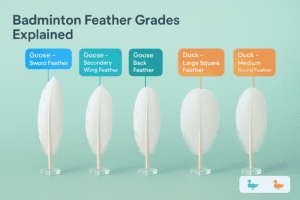Introduction
The shuttlecock is an essential component of badminton, influencing the game’s dynamics and performance. Understanding the materials and construction of shuttlecocks can enhance your appreciation for the sport and help you make informed choices when selecting equipment. In this deep dive, we will explore the key elements of badminton shuttlecocks, including cork, feather, glue, and thread. Whether you’re a casual player or a serious competitor, this knowledge will enrich your badminton experience.
Understanding the Components of a Shuttlecock
1. Cork: The Base of the Shuttlecock
The cork serves as the base of the shuttlecock and plays a crucial role in its performance.
- Material: High-quality shuttlecocks typically use natural cork harvested from cork oak trees. This material is favored for its durability and ability to withstand impact.
- Types: There are two main types of cork used in shuttlecocks:
- Natural Cork: Provides better performance and durability but is more expensive. It is often found in professional-grade shuttlecocks.
- Synthetic Cork: Made from composite materials, synthetic cork is more affordable but may not perform as well as natural cork. It is commonly used in recreational play.
2. Feather: The Flight Mechanism
Feathers are integral to a shuttlecock’s flight characteristics, affecting its speed and stability.
- Material: Traditionally, feathers are sourced from geese or ducks. Goose feathers are preferred for high-quality shuttlecocks due to their durability and aerodynamic properties.
- Construction: A standard shuttlecock typically uses 16 feathers arranged in a circular pattern around the cork base. The feathers are carefully selected for uniformity in size and shape to ensure consistent flight.
- Impact on Performance: The type and quality of feathers significantly influence how the shuttlecock behaves during play. Higher-quality feathers provide better control and a more stable flight path.
3. Glue: Binding It All Together
Glue plays a vital role in constructing a shuttlecock, ensuring that all components stay securely attached.
- Types of Glue: The adhesive used in shuttlecock manufacturing must be strong enough to withstand repeated impacts while remaining flexible to accommodate the natural movement of the feathers.
- Application: Glue is applied during the assembly process to bond the feathers to the cork base. Proper application ensures that the feathers remain firmly attached throughout their use.
4. Thread: The Finishing Touch
Thread is used to secure the feathers and provide additional stability to the shuttlecock.
- Material: Typically made from nylon or polyester, the thread must be durable yet lightweight to avoid affecting flight dynamics.
- Construction Technique: The feathers are stitched into place using thread to ensure they remain secure during play. This stitching process is critical for maintaining the integrity of the shuttlecock.
- Aesthetic Considerations: The color of the thread can vary based on manufacturer preferences, but it generally complements the overall design of the shuttlecock.
Performance Factors Influenced by Materials
A. Speed and Control
The combination of cork type, feather quality, and construction methods directly affects how quickly a shuttlecock travels through the air. Natural cork with high-quality feathers typically results in faster speeds and better control during play.
B. Durability
Shuttlecocks made with premium materials—such as natural cork and goose feathers—tend to last longer under competitive conditions compared to those made with synthetic materials.
C. Flight Stability
The arrangement of feathers and their quality significantly influence flight stability. Well-constructed shuttlecocks maintain their trajectory better, allowing players to execute precise shots.
FAQs Section
Q1: What type of shuttlecock should I use for practice?
A1: For practice, synthetic cork shuttlecocks are often sufficient; however, if you’re training for competition, opt for natural cork feathered shuttlecocks for better performance.
Q2: How long do feathered shuttlecocks last?
A2: Feathered shuttlecocks can last anywhere from a few games to several weeks depending on usage intensity and quality; higher-quality options tend to last longer.
Q3: Can I repair a damaged shuttlecock?
A3: While minor repairs can be attempted (like reattaching loose feathers), it’s generally recommended to replace damaged shuttlecocks for optimal performance.
Conclusion
Understanding the components that make up badminton shuttlecocks—cork, feather, glue, and thread—can greatly enhance your appreciation for this vital piece of equipment. By choosing high-quality badminton materials suited to your playing style, you can improve your performance on the court and enjoy a more fulfilling badminton experience.
If you’re looking for premium badminton equipment or accessories, visit badmintonsupplier.com today! Elevate your game with top-notch gear!







